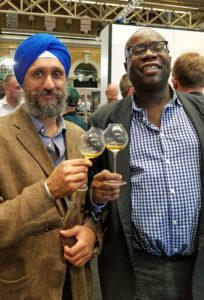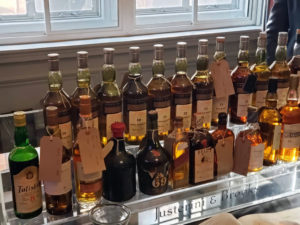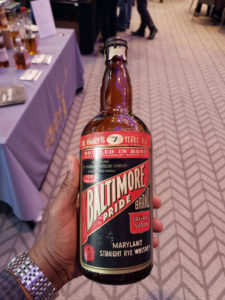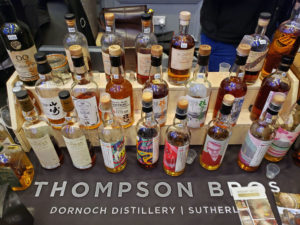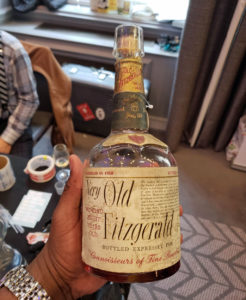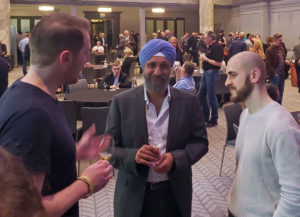By Kurt Maitland
Last year, I had the pleasure of interviewing Sukhinder Singh, the co-owner and founder of online retailer The Whisky Exchange, prior to the start of the 2019 Whisky Show.
Briefly, Sukhinder is quite the force in the whisky industry. He’s been a collector since the late 1980s, and the bottles in his personal collection that are hard to beat in depth or breath. The Whisky Exchange is one of the leading whisk(e)y retailers in the world and they’ve expanded their business to curating what I think are some of the best whisk(e)y events around.
We covered a variety of topics in our conversation, such as their two shows (The Whisky Show and The Whisky Show: Old & Rare), Japanese whiskies, independent bottlings and some of their future plans. This interview will be split into two parts, with this one focusing on the whisky shows and the other focusing on their independent bottlings and future plans.
As this interview goes to print, The Old and Rare will be upon us shortly, and we will still have the Whisky Show in the Fall to look forward to. Although I recorded it as part of last year’s The Old and Rare, it remains as current as ever. Count this as a primer if you’re attending this weekend, and if not, The Whisky Show proper awaits in the Fall.
KM: So how did you come to start the Whisky Show?
SS: When the first whisky events started, there were one or two in Europe and there was Whisky Live in London and they were okay. Afterwards Limburg started, which I love. It was run by a good friend of mine and they asked me to come and exhibit some old and rare products. It became an annual pilgrimage. Then Whisky Live Paris started and I used to go to that occasionally but not every year and it was good.
I guess what frustrated me a little was the fact that the shows in the UK weren’t amazing. They were okay but the Europeans were doing it much better than us. It frustrated me and I thought it was wrong. The UK is the home of whisky – of Scotch. And we’re not doing a good job here.
So I was thinking it’d be great to do something but I never really got around to doing it.
Then a gent came to see me and proposed the idea of running a whisky show of some sort. And his idea was completely flawed to me. He was trying to do what everyone else was doing and for me there was no point. What is the point of doing something similar? “Because we’ll do it better?” Fine, you’ll do it better but I still think it’s wrong.
So, my vision was that London is one of the cities that you can call the center of the world. I felt that if somebody was going to do something in the UK, it needed to be premium.
The distillers had started launching some really nice well-aged expensive product but they would never take them to the shows. They felt that they would be abused. You got a cheap and cheerful ticket price, let’s say 30 pounds and people would be coming there to drink as much as they want or as much as they could. No one was really interested in bringing expensive product. So, I felt let’s do a premium show. Charge a premium ticket price and bring in the right type of customer. Convince the brand owners that we will bring you the right customer if you bring the right product. You make all this lovely amazing aged whiskey. You need to show it off, yeah? It’s all well telling me about “Look how beautiful it looks” “Look how wonderful it is” “limited edition this” and “limited edition that”. Let’s go and talk to people about the liquid because that’s how we are going sell it.
So, we did the first show. It was I think 90 pounds a ticket. 11 years ago, it was a lot of money. Everyone said, “You’re crazy”. I said, doesn’t matter. That’s what I want to do.
But what we did differently is that as part of the ticket price we provided a buffet lunch. So that people had time to relax and not just drink for six or seven hours straight. People had the view that “Oh my god, I don’t want to leave the venue because I’ll miss valuable drinking time”. People sadly have a habit that unless there is something very local or in the building they just don’t want to go. They don’t want to leave the venue and walk 10 minutes to go and get something.
KM: And they don’t want to queue up to get back in.
SS: For me was: let’s make it an experience. Let’s make it a relaxed day, which you go through pairings, you’ve got food, you’ve got great whiskeys in a premium atmosphere.
And some good aged whiskies. We came up with the concept of the Dream Dram, it seems that it has been copied many times, yes?
And I think it was the right thing. You know what’s lovely? We look at the special whiskies which are being launched and we aspire that one day we’ll be able to try them. What we came up with was a Dream Dram token, which gave everybody the chance to get one dram free of charge, between 500 to 1000 pounds, something maybe they will never ever get a chance to try. And I think that’s what made the show really special, that the brands loved it, consumers loved it. It was a perfect marriage.
KM: I find your shows, both The Whisky Show and The Old and Rare as among of my favorite shows of the year. You’ve seen me there. I tell my friends it’s worth the money. It’s worth the trip.
I find that at many whisk(e)y shows you run into the problems you bring up – people thinking “I’m only here for this one day, let me get as much as I can”, etc. Instead of actually exploring the whiskies and learning, people come in to drink as much as they can and go to booths asking, “What’s your most expensive pour?”. Truth be told, the most expensive pour might not be the whisky you really end up liking. It might be that the middle of the range or even the beginning is better for you. If they take that bit of time and engage with the brand, maybe you can have that discussion. They can talk about what you like, you can taste some stuff and maybe we figure out what do you really like on the table.
SS: The other thing that we did is that, I find that in some shows the special stuff is segregated into a different room or a different area like a VIP area or on a particular stand and for me that’s the wrong way to do it. I believe these whiskeys were made by the brand owners, many years ago, maybe their predecessors, and should be shown off as part of the brand. We make sure these dream drams are on the brand’s table. By doing that you drive traffic to the stand. You get a chance for the brand owner or rep can talk to you and say you know what, try the dream dram but before that I want you to introduce you to something else.
KM: That dream dram might be once in a lifetime, but you know what, this dram could be the rest of your lifetime. You might find the dram in here that you love, and you can go home and pick up at the store right now.
I also love the fact that you have a store on premise. You tasted it, you can buy I and have it held for you. At the end of the night you go home tonight with a bottle you liked.
SS: We also took a very very different approach to master classes. For literally every show in the world, the classes are led by brands. Everyone goes out to the brand owners and says, “Would you like to do a class” and they say “Yes, we would, this is what we’re doing.” For us, we curate every single class ourselves, and we then go back to the brand and say “We would like you to do a class and this is the concept of the class.” And honestly, sometimes it’s very complicated to convince them, especially when you have to go through marketing.
KM: Right.
SS: You’ve probably seen over the last four or five years we’ve done these trio classes – Three masters, three legends. This year we have three Japanese masters. Those classes are impossible to do. To get three different brands on the same stage with each other, especially like this year’s class – Three Japanese masters. To have Nikka, Suntory and Chichibu on the same stage next to each other. That’s unheard of, yeah?
KM: I do some whisky classes in the States, and I when I do Japanese whisky I say, it’s funny how in the case of Nikka and Suntory, they have excised the fact that they have a co-joined history. When you go to Suntory/Yamazaki, “Well, your original master distiller’s notes. That’s Masataka Takatsuru, the person who founded Nikka.” Never mentioned.
For Nikka, that part of his history doesn’t exist – He honed his craft on those on those original Yamazaki stills but the fact that it was for their main competitor keeps them from including it in their story. Which is a shame because if as a fan you knew the connection, it would let you better compare and contrast the styles of the two whiskies.
Speaking of Japanese whisky I was talking to another friend about Kirin and what they did with Karuizawa, (Editor’s note – Karuizawa is considered the Japanese Macallan and the distillery was demolished instead of restarted several years ago). It drove me nuts to read about this. Kirin’s wealthy, they’re still trying to develop their whiskey and see whether it’s a global brand or at least get a bigger national presence. I think they could have restarted the distillery if they wanted to.
SS: 100% percent
KM: They had options. I know that Ichiro Akuto (the owner of Chichibu) was willing to help them and he had worked at Karuizawa in the past. The last master distiller is still alive. I also think Ichiro would have bought the distillery if he could. Maybe he would have run it as a separate business from Chichibu and try to get investors involved but he would have tried. I’m sure Nikka and Suntory would have looked into it. But because they didn’t want to renovate the distillery, they basically decided to scorch the earth. It seems like their thoughts were “We don’t want to rebuild it.” They knew what would happen if it somebody else bought it and without a doubt, somebody would have, so they decided we’re just going to take it apart. That way nobody has it and it’s not future competition. And that one kind of hurt, because again, here’s a company that has the resources to do make a move and they wanted to be a bigger player on the whiskey market. To have that iconic distillery as part of their portfolio would have been a nice cherry on top of their current efforts but that’s a different discussion.
SS: I agree I think it was a it was a shame. It was a waste.
I was quite involved in the Karuizawa scenario, you know. I was fortunate that the guys who had access to the stock brought me in the very early stage, I was going to be one of the partners to buy it. The deal happened in a very different way. But we had first access to the stock, and we bought in a number of casks. Probably one of the best things I ever did in my life. In hindsight, I should have bought the whole stock but I couldn’t afford it.
But I saw that in a space of one year they bottled I think close to 1000 casks. And that stock just disappeared. Now, it was pretty old stock and they sold it as cheap Japanese blended whiskey in Japan. I couldn’t believe it. I just couldn’t believe it.
KM: Because this is the issue of foresight. Somebody wanted to cash out, instead of thinking “let’s if we sit back and see what we can do with it. Let’s do a limited release.”
SS: I think their priorities but different because beer is so big. They couldn’t understand the scope or they felt they would have to do so much work, and actually all their energy is currently on beer and they’re doing well in beer so let’s forget it.
KM: I think also it’s the timeframe, with beer you know that if I make beer right now…
SS: Correct.
KM: …. I’m bottling it, I’m putting it on the store. I don’t have to wait. To do what Daftmill did and wait ten years to put out an official release, that’s a stretch for most companies.
So what can you tell me about the first whisky show you curated? How was the first when you compare it to the present?
SS: Okay, as I said one thing which we always had the foresight to do was to keep it premium. So our first show, in many ways you could say it was possibly even more premium than it is today. It was the Guild Hall.
It was the most beautiful setting. And what a way to start. So, you know for exhibitors it was, “Wow, Sukhinder, you have elevated whiskey to a different level.” Because you know, since I was a kid all I’ve been hearing was “Single malt is special, single malt is premium, single malt takes a long time to make.” I don’t feel that from you. Let me teach you how to do it.
KM: Right.
SS: So the first show, the ticket price was 90 pounds. It was a challenge to get people in, I think, over the two days, Saturday, Sunday we managed to get in around 300 people in the two days yeah?
Now we do around 5000 people over three days, close to. So that’s a big difference, right? I think it was smaller, of course but it was still very premium.
I mean, the nice thing was because ticket price was high, we got very few customers, but we got the right customers, see my point?
Because anyone who bothered to spend 90 quid was serious. So, everyone was so happy because you know what? They were the customers we want to talk to which they had never been able to do before.
KM: There is a qualitative difference. Same with The Old and Rare show in Glasgow. I ran into guys that I didn’t expect to see at show. People who don’t come out to shows because they don’t have to.
SS: Talking about The Old and Rare Show, I think for me, probably the nicest compliment I’ve ever had was from Serge Valentin (whisky blogger, Whiskyfun.com). He came up to me and said “Bravo!” He goes, “You know what, I love the atmosphere. I love that there’s not too many people. I love that it’s relaxed. I love that you have so many nice people, important people here who are friends. And he goes, the setting is just perfect, the grounds are just perfect.” He goes “Bravo.”
KM: It’s true. I’ve been to other festivals and what I don’t see at your festivals is I’m talking to somebody and there is a person reaching over me to get something. I’ve talked to brands, and what they hate is when somebody comes up and interrupts whatever they’re doing, takes their glass and sticks it in the person’s face and is basically reenacting the movie Oliver and asking for more. Except they aren’t asking for more, it’s more demand than request i.e.“You give me this.”
And the thing about good whiskey, just like with a good cigar, it’s something you need time to appreciate.
SS: People say to me “Oh my god people are spending, you know, a hundred pounds on a ticket. They must be wasted at the end.” No, because the environment is such, the pace is such that people just go with the flow like everybody else. And everyone just says, you know what, I’m going to learn. I’m going to take my time and it’s just beautiful.
KM: And because it’s over the two days and normally it’s three. You might make a game plan: we’re going to work on these whiskies this day and these whiskies this day and figure out who I want to meet and talk to and see. And you’ll just go through and do what you can. But there’s no sense of having to rush. There is the queue for some of your special bottlings but that’s going to happen. It’s just a line. The line is not somebody drunkenly staggering around.
So now, what do you enjoy the most about your events?
SS: Our job is to make sure the consumers happy and the exhibitors happy. This is not a business for me, this is, this is for the love, yeah? So, I think I’m fortunate because I’m not physically working there. You understand? Even from day one, because I love whiskey, I want to enjoy my own show. I’m one of the few you will find who runs the show and he’s actually out enjoying his own show.
KM: (Laughing) I have pictures of you enjoying your show.
SS: I talk to people. Before the show starts, I talk to all the exhibitors. I welcome them. I say hi. You know you meet a lot of old friends and throughout the show you meet so many people. People are so nice to come every year.
So, for me it’s making sure everyone’s happy. You occasionally pick up a few problems here. Doing the level of the classes we do, having the quality of whiskies and dream drams that we have, each year becomes a bigger challenge as you can imagine.
It’s funny because I remember from after the first two shows, people would say that was amazing. And next year people would say that was amazing. It was so much better than last year. Then the following year. That was amazing. It was so much better than last year. I’m like “Last year wasn’t bad.” (chuckling).
So, it’s just walking around, learning how we can improve, be it the layout, be it the flow. Be it you know, do we have enough people? Do we have too many people? We are always very conscious, I don’t want to have a show which is you know like shoulder to shoulder, as you say, hands over your shoulder. We’re trying to maintain it to a level which is just right, yeah?
I mean for me when I look at it now – how much bigger can I grow it? And in my mind, I can’t grow it much bigger. There is only one venue left for me to go to if I moved from Old Billingsgate (current home of The Whisky Show) and that is an exhibition center. And I don’t think that is right for my show. So, I think for me, we will just take it to the point that we are happy, and we will maintain it. If it sells out it, it sells out.
One thing we are doing next year (Editor’s note: that would be 2020, as this interview was recorded on the eve of last year’s Whisky Show) or at least the plan is, i.e. we’re working on it – we’re going to add a Friday evening. So next year is going to be Friday evening, Saturday, Sunday and Monday is trade. We’re looking to entice a new customer or a different type of customer.
We’re going to try and work with some corporates – institutions, banks, insurance companies to see if they want to bring staff etc, etc. just to try a different angle.
For me, if we achieve that. I think that is it. We will maintain it to where we can take it and that will be it.
KM: So, let’s talk about The Old and Rare Show. Which is a personal favorite of mine is, as you well know. How did that come about because it’s a relatively recent addition?
SS: I think really the idea was very similar. That, how come the Europeans especially, are doing it better than us. And for me, it always frustrated me why there was no show in the real home of whisky, i.e. Scotland.
I looked at doing this two or three years before we actually started. I had a slightly different concept. I wanted to do it at a distillery and move every year to a different distillery.
And the complication became – basically I wanted to make it a fun weekend where people do the show during the day. You have a big barbecue in the evening at the distillery and then people retire and come back. You know, a fun weekend.
KM: Kind of like a mini Islay/Feis Ile.
SS: Yes. The problem became logistics, not enough hotels, people would have to travel too far.
KM: It is Scotland and it’s not London. London is a bit different.
SS: We looked at a number of places and how we could do it, but it became a bit of a mammoth task. And then my team became too busy because we were planning on other shows and other events.
So, then Angus and Johnny (Angus MacRaild and Johnny MacMillan) came to me saying “Sukhinder, you’re not doing this show, we’re doing this.” I was like “What you mean you’re doing it?” and they said “But we want you to come in with us. I was like, alright, boys, let’s do it.”
They are great guys, they’ve got their own skill set, you know they’re crazy as well about whiskey. I think we had the infrastructure; we have the team; we have the experience and we have the database. They have the passion and I think you know we did for the love.
Again it’s, it’s a very complicated show to put together. You know, to keep chasing people to get that broad range of exhibitors together. Johnny knows some of them well. Angus know some of them. I know some of them and we work together, and we just get it done. You know, so we do it for the love, and it’s just great fun.
KM: Yes, I’m already planning to go.
SS: Only problem we’ve had is, I’ve always wanted to move it and travel it around Scotland. So, the plan was that was for 2020 would move to Edinburgh but we’ve had some issues with licensing in terms of one oz pours.
Per legislation, pours need to be standard measures, each is a 25ml. And they wouldn’t allow us to do one 10th of one cl. So, we’ve been going back and forth, back and forth, appointed a lawyer, etc., but as time moves on we’re quite limited to where we can do it and we couldn’t get our old venue in Glasgow so this year the Old and Rare will be in London.
Hopefully, we can take it back to Scotland. If London is a huge roaring success and people saying they prefer London because it’s easier to get to, we have a bigger target audience in a locally as well. We will see.
Editor’s note – This will conclude part 1 of our 2 part interview with Sukhinder Singh. The 2020 Old & Rare Show kicks off Feb 29th and March 1st so I’ll have to report back with some of the highlights
 The Whiskey Reviewer A World of Whiskey, Poured Every Weekday
The Whiskey Reviewer A World of Whiskey, Poured Every Weekday
